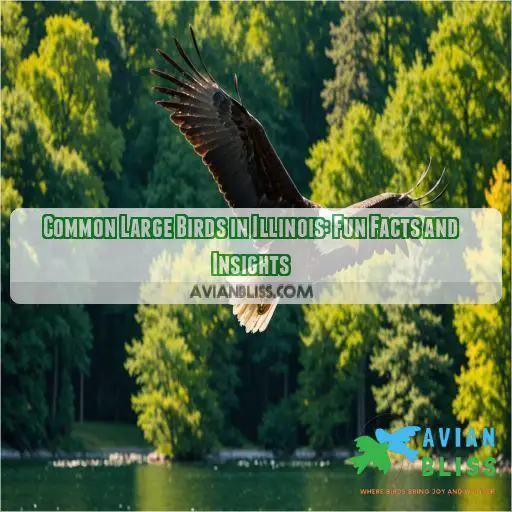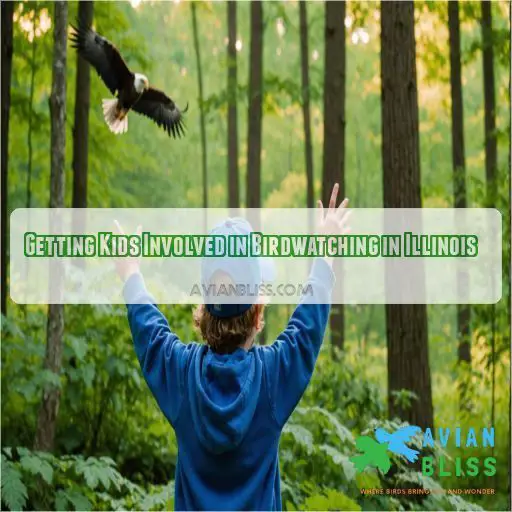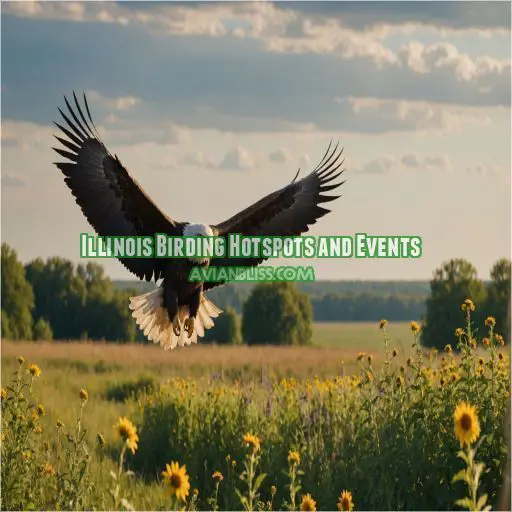This site is supported by our readers. We may earn a commission, at no cost to you, if you purchase through links.

Spot agile Cooper’s hawks darting through the trees or watch turkey vultures performing their essential cleanup duties.
Whether you’re near lakes or wooded areas, these birds are frequent fliers, showcasing grace and power.
A tip? Keep an ear out for those distinctive calls—they’re nature’s symphony.
Intrigued by birdwatching or curious about their secret lives? You might be surprised by what else can be found in this feathered world!
Table Of Contents
- Key Takeaways
- Large Birds of Prey in Illinois
- Large Water Birds in Illinois
- Other Large Birds in Illinois
- Birds of Prey in Illinois: Identification and Habitat
- Birdwatching in Illinois: Best Spots and Times
- Common Large Birds in Illinois: Fun Facts and Insights
- Large Birds in Illinois: Conservation Status and Threats
- Getting Kids Involved in Birdwatching in Illinois
- Illinois Birding Hotspots and Events
- Frequently Asked Questions (FAQs)
- What big birds have long tails in Illinois?
- What is a large gray bird in Illinois?
- What is the largest hawk in Illinois?
- What is the large white bird in northern Illinois?
- What is the largest bird in Illinois?
- Can Trumpeter Swans be found year-round in Illinois?
- How do Sandhill Cranes communicate?
- Are Double-crested Cormorants present in Illinois throughout the year?
- Which large birds in Illinois are invasive species?
- Conclusion
Key Takeaways
- You’re in for a treat with Illinois’s skies full of avian marvels, including red-tailed hawks and great horned owls. These are the headliners of the birding world, offering thrills and chills with their impressive calls and soaring acrobatics.
- turkey vultures might not win any beauty contests, but they’re nature’s cleanup crew, efficiently removing carrion. You’ll often spot them lazily riding thermals, showcasing their essential role in the ecosystem.
- By the wetlands, keep an eye out for elegant great egrets and quirky double-crested cormorants. These water birds excel at fishing, whether it’s the egret’s calculated wading or the cormorant’s underwater ballet.
- Birdwatching in Illinois is like attending nature’s symphony. From the haunting hoot of the great horned owl to the unmistakable screech of the red-tailed hawk, immerse yourself in a soundtrack that beats any mixtape.
Large Birds of Prey in Illinois
Illinois is home to an impressive array of large birds of prey. From the iconic red-tailed hawk with its unmistakable call to the elusive great horned owl, these magnificent raptors rule the skies across the state, and learn to identify owl sounds to spot them in action.
Red-tailed Hawks Have Impressive Calls That Are Easily Identified
Listening for red-tailed hawk calls is like tuning into nature’s radio. These hawk vocalizations are iconic and help in hawk identification. Their distinct screech can be heard throughout Illinois, making birdwatching exciting. Keen ears will recognize this classic sound amid the white-noise of the woods! So, next time you’re outside, listen for those remarkable hawk sounds soaring above.
Great Horned Owls Are Common Large Birds in Illinois
If you’re thrilled by the commanding calls of the red-tailed hawk, the great horned owl will capture your imagination too. These large birds are true night hunters, with a varied diet that keeps them thriving across habitats.
- Marvel at their breathtaking hoots!
- Admire their majestic presence in Illinois forests.
- Protect these icons of safety from threats.
Red-shouldered Hawks Are Known for Their Hunting Style
When you’re out birdwatching, keep an eye (or should I say a hawk eye?) for the Red-shouldered Hawk‘s dynamic hunting techniques.
These raptors swoop through wooded habitats, skillfully capturing prey with precision.
Want a closer look? Grab your birdwatching checklist and head to birding locations with dense forests.
Always check local conservation concerns to make sure you have positive wildlife interactions!
Coopers Hawks Are Known for Flying Agility
You’ll be amazed by the aerial acrobatics of the Cooper’s hawk! These agile predators are known for their lightning-fast flying speed and impressive hunting techniques. Keep an eye out for them swooping through wooded areas, as they deftly maneuver to catch their small bird and mammal prey. A true marvel of nature!
Turkey Vultures Are Found in Forested and Open Areas
Turkey vultures are the cleanup crew of North America, feasting on carrion and playing an essential role in the ecosystem.
You’ll spot them soaring over open fields and forests in the United States.
Their remarkable sense of smell guides them to meals.
While not endangered, they are protected by law.
Grab your field guide and explore birding hotspots to appreciate their unique nesting behavior and scavenging habits.
Large Water Birds in Illinois
In Illinois, you can spot an incredible variety of large water birds, from the loud honking Canada Geese to the cleverly fishing Osprey. Whether you’re captivated by the majestic Great Egrets or amused by the Double-crested Cormorants drying their wings, these birds bring life and laughter to our waters.
Canada Geese Are Extremely Common
If you’re talking about large water birds, Canada Geese are the undeniable superstars of Illinois. Known for their honking calls and distinctive V-shaped migrations, these geese are everywhere, often seen waddling around parks. Their nesting habits can be charming yet chaotic, making goose management essential! So grab some binoculars and enjoy bird photography or bird watching these fascinating creatures!
Osprey Have Unique Talons Adapted for Catching Fish
One of the most unique birds you’ll spot in Illinois is the Osprey, with its distinctive talons perfectly adapted for snatching fish from the water. These skilled "flying fishermen" have reversible outer toes and spiny pads to firmly grip their slippery prey, allowing them to dive up to 125 km/h to catch their next meal.
Great Egrets Are Found in Wetlands and Near Water
Just like ospreys near water, great egrets wade majestically through wetlands and shallow shores. Picture these graceful giants tiptoeing like ballet dancers, scouting for fish with unparalleled focus. Their habitats are abundant with reeds and water—you’ll spot them hunting and nesting here. Despite their serene grace, egrets face threats; conservation efforts are pivotal to their survival.
Double-crested Cormorants Are Expert Divers
Like Great Egrets, Double-crested Cormorants frequent watery habitats in Illinois. Known as expert divers, these sleek water birds are like underwater acrobats. They hunt fish with precision that would make any angler envious! Their unique diving techniques make them fascinating to watch. Spot these birds near lakes and rivers, but be mindful of conservation efforts to protect their habitats.
Other Large Birds in Illinois
When you’re exploring the diverse landscapes of Illinois, don’t be surprised if a wild turkey waddles across your path.
You might also hear the peculiar "drumming" of the pileated woodpecker in mature forests.
While snow geese honk noisily overhead in massive flocks during migration, barred owls might watch silently from wooded shadows.
Though elegant, the beautiful mute swans glaring from park ponds are definitely not from around here!
Wild Turkeys Are Common in Clearings and Along Roadsides
You’re likely to spot wild turkeys strutting through clearings or along roadsides in Illinois.
These impressive birds are known for their large size, distinctive feather patterns, and loud gobbling calls.
While they may seem intimidating, wild turkeys are generally quite shy and prefer to avoid close encounters with humans.
Keep an eye out for these majestic birds as you explore the great outdoors in Illinois!
Pileated Woodpeckers Are Found in Large, Mature Forests
While wild turkeys strut in open fields, you’ll find the incredible pileated woodpecker hammering in large, mature forests. Their drumming echoes like a forest concert. To spot these "Nordic warriors" of the bird world, look for:
- Distinctive red crest
- Rectangular tree holes
- Bug-infested wood for their diet
- Your own patience in listening to their calls
Barred Owls Are Common in Wooded Areas
Unlike the flashy woodpeckers, Barred Owls prefer a quiet life in wooded areas.
You might hear their iconic "Who cooks for you?" calls echoing through the forest.
They nest in tree cavities and feast on small mammals.
Watch out, though—great horned owls pose a threat.
Keep your ears perked for these feathered predators with a keen eye for nighttime adventures.
Mute Swans Are Not Native to Illinois
Mute swans, those graceful beauties, aren’t Illinois natives! These birds, with their snowy plumage, were introduced and now ruffle feathers among local wildlife. While their elegance enchants, they compete with native birds for food and habitat. Conservation efforts focus on balancing their impact. Remember, swans are lovely, but let’s make sure they don’t hog the spotlight from Illinois’ rightful residents!
Snow Geese Are Found in Large Flocks During Migration
As the weather turns colder, you may spot large flocks of snow geese passing through Illinois during their annual migration. These striking white birds with black wing tips gather in massive groups, their honking calls echoing across the landscape. Look for them in open wetlands and fields – they often stop to rest and refuel before continuing their journey south.
- Snow geese migrate in large flocks, sometimes numbering in the thousands.
- They travel along established migration routes, often following major river systems.
- Snow geese spend their winters in southern regions like the Gulf Coast.
Birds of Prey in Illinois: Identification and Habitat
Illinois is home to a diverse array of feathered inhabitants, including large birds of prey.
These sky predators offer exciting birdwatching opportunities.
You might spot a red-tailed hawk with its impressive calls.
Or perhaps you’ll see the agile Cooper’s hawk zipping through the trees.
The Great Horned Owl’s eerie hoot might even make you feel like you’ve stepped into a spooky movie set, especially during breeding season.
What Big Birds Have Long Tails in Illinois?
If you’re looking for big birds with long tails in Illinois, check out the Red-tailed Hawk! Its impressive tail serves as more than just a tail feather duster—providing stability during flight. You might even say it wags its tail like a pooch on a summertime chase! Red-tailed Hawks are fairly common, making them a real treat to spot.
What is a Large Gray Bird in Illinois?
So, you’ve spotted a big bird with a gray hue in Illinois, huh? It’s likely the Great Blue Heron, majestic and common around waters. Here are some tips to sharpen your bird identification skills:
- Note the Size: It’s quite large.
- Habitat: Often near water.
- Color: Mostly gray.
- Pose: Gracefully stands tall.
What is the Largest Hawk in Illinois?
The Red-tailed Hawk is the largest hawk found in Illinois. With its impressive 43-55 inch wingspan and 1.5-3.5 pound weight, this majestic raptor is a common sight soaring over fields and forests. Look for its distinctive reddish-brown tail and broad, rounded wings as it hunts for small mammals and birds. These adaptable hawks thrive in a variety of habitats across the state.
| Hawk Trait | Measurement |
|---|---|
| Length | 18-26 inches |
| Weight |
1.5-3.5 pounds
What is the Large White Bird in Northern Illinois?
After exploring hawks, let’s spot the large white bird in Northern Illinois. It could be the American white pelican, soaring with a wingspan of 7-9 feet. Or maybe the graceful tundra swan, a regular winter visitor. Finally, the elegant great egret, with its snowy plumes, often found wading through wetlands. Keep your binoculars handy!
Birdwatching in Illinois: Best Spots and Times
When you’re birdwatching in Illinois, timing and location are everything to make the most of your adventure. Whether you’re hoping to catch a glimpse of magnificent white pelicans or graceful kites soaring above river bluffs, knowing where and when to look guarantees you won’t miss out on these incredible sights.
The Best Months to Observe White Pelicans
You’ll have the best chance to observe white pelican migration in Illinois during March, April, September, and October.
These majestic birds, known for their synchronized flying feats, stop at spots like Lake Chautauqua!
Witness them scoop fish in groups, turning the art of fishing into a choreographed dance.
Don’t miss the chance to enjoy their pelican behavior and thrill at nature’s spectacle!
Search for Kites Along River Bluffs and Bottomland Forests
To spot kites along river bluffs and bottomland forests, keep an eye out in spring, summer, and early fall.
Look for their distinctive silhouettes soaring effortlessly on the wind.
The best places to search are the Union County Conservation Area and Fort Kaskaskia State Historic Site.
With a keen eye and a bit of patience, you might just catch a glimpse of these graceful birds of prey.
Common Large Birds in Illinois: Fun Facts and Insights
Birdwatching in Illinois is full of surprises, especially when you realize that some swans are actually quite chatty. Keep your ears open as you explore, because these big birds often make themselves known with distinctive calls!
These Large Birds Are Easy to Hear in Illinois
Bird calls in Illinois are as diverse as they’re delightful, especially at night. With the loudest birds grabbing your attention, you’ll hear their melodic bird songs filling the air. In a table below, discover who’s making all that noise:
| Bird | Bird Call Description | Volume Level |
|---|---|---|
| Red-tailed Hawk | Screeching cry | High |
| Great Horned Owl | Deep hoot | Medium |
| Sandhill Crane | Bugling call | High |
Identifying birds becomes easy with these distinct sounds!
Despite Their Name, These Swans Are Not Mute!
Despite their name, Mute Swans are surprisingly chatty—a peculiar twist! You won’t catch them silent when they’re:
- Courting: Their calls and graceful neck displays during mating are like nature’s romance novel.
- Guarding territories: Expect loud honks as they defend their watery domains.
- Parenting: Their nurturing behavior includes gentle calls to guide cygnets safely.
These swans fend off threats with remarkable flair.
Large Birds in Illinois: Conservation Status and Threats
While many of Illinois’ large birds are thriving, some species face conservation challenges. Learn about the threats these magnificent creatures encounter and the efforts underway to protect them for future generations to enjoy.
Learn More About Other Birds in Illinois!
Curious about Illinois’s avian wonders? Get started with birdwatching using this handy table to guide your journey:
| Bird | Size | Habitat | Behavior | Migration |
|---|---|---|---|---|
| Bald Eagle | Large | Near water | Majestic flying | Northern move |
| Red-tailed Hawk | Medium | Varied | Soaring | Partial or resident |
| Great Blue Heron | Large | Wetlands | Slow flight | Seasonal |
| Sandhill Crane | Tall | Wetlands | Loud calls | Long-distance |
| Pileated Woodpecker | Medium | Forest | Tree-drumming | Local movement |
Protecting these favorite habitats helps continue enjoying them.
Threats to Large Bird Populations in Illinois
Large bird populations in Illinois face several challenges, like a pesky swarm of mosquitos! Primary threats include:
- Habitat loss from urban development gobbling up forests.
- Climate change, altering migration patterns like an unpredictable GPS.
- Pesticides, wind turbines, and lead poisoning threaten these majestic creatures’ safety.
Stay informed to help them survive and have the freedom to soar!
Conservation Efforts for Large Birds in Illinois
You learned about threats to large birds.
Now, let’s chat about conservation!
Efforts focus on tackling habitat loss, minimizing bird strikes, managing invasive species, and addressing climate change.
Use ways to reduce pesticide use to keep these beautiful creatures safe.
You’re part of the solution—create bird-friendly habitats at home and support conservation initiatives for a thriving bird ecosystem in Illinois.
Getting Kids Involved in Birdwatching in Illinois
Birdwatching is a fantastic way to get kids engaged with nature. Why not take them on an adventure to spot some of Illinois’ impressive large birds like soaring hawks and majestic eagles?
Get Kids Bird Watching
While conservation is a big deal, getting kids into birdwatching helps future generations care for birds. Here’s how you can start:
- Invest in kids’ binocularslet them feel like explorers!
- Organize nature walks, transforming them into exciting quests.
- Set up bird feeders at home and help them identify birds right from your doorstep.
These activities spark joy and curiosity!
The Most Common Spots for Bird Watching in Illinois
While getting kids into birdwatching, explore Illinois’ top spots like Lake Chautauqua and the Mark Twain National Wildlife Refuge. Grab an Illinois bird guide, pack some snacks, and watch their eyes sparkle with each unique bird sighting Illinois state bird. These birdwatching hotspots are perfect for beginners, offering safety, understanding, and a touch of adventure. Let the birds be your tour guides!
Backyard Bird Count in Illinois
Jump into the exciting world of citizen science by participating in the Backyard Bird Count in Illinois. Equip your backyard bird feeders to attract:
- Common backyard birds like finches
- Bright-red cardinals
- Curious chickadees
- Spirited sparrows
Share your sightings with budding naturalists! It’s a chance for kids (and adults) to connect with nature and nurture a love for birdwatching.
Top Backyard Birds to See in Illinois
Often, the most common backyard birds in Illinois are the familiar American Robin, Northern Cardinal, and Blue Jay common backyard birds. To attract these feathered friends, consider installing bird feeders, providing a birdbath, and planting native shrubs and trees. With a little effort, you can create a vibrant backyard oasis for birds to thrive.
| Common Backyard Birds | Habitat Preferences | Feeding Habits |
|---|---|---|
| American Robin | Open areas, lawns | Omnivorous, eats worms, insects, berries |
| Northern Cardinal | Wooded areas, shrubs | Seed-eaters, enjoy sunflower seeds, suet |
| Blue Jay | Deciduous forests, parks | Omnivorous, cache acorns and nuts for winter |
Illinois Birding Hotspots and Events
Explore Illinois birding hotspots where you can spot majestic eagles and agile hawks amidst stunning landscapes like the Bald Eagle. From the serene beauty of Lake Chautauqua to the vibrant Hyde Park, there’s no shortage of feathery wonders—it’s like a safari in your own backyard!
Lake Chautauqua and the Mark Twain National Wildlife Refuge
Getting your kids into birdwatching? Lake Chautauqua and the Mark Twain National Wildlife Refuge are hidden gems for wildlife viewing. Picture majestic eagles swooping by as you explore Refuge History through charming trails. It’s pure conservation magic crafted over decades. Bring a picnic, gather visitor information in advance, and who knows—maybe you’ll spot a rare sight!
The Illinois River in Southwestern Illinois
Flowing through the heart of the state, the Illinois River invites you to witness its impressive bird diversity. Birdwatching tips? Keep your eyes peeled for bald eagle nests perched in towering trees. Illinois’s conservation efforts help maintain these habitats, offering you a glimpse of nature’s wonders. Your visit supports this delicate ecosystem, making you a hero in nature’s tale!
Hyde Park and Jackson Park
Nestled right in Chicago, Hyde Park and Jackson Park offer prime birdwatching opportunities. 1) Spot colorful parakeets flitting between the trees, 2) attract backyard birds with strategically placed feeders, and 3) explore the park’s bird sanctuaries for a chance to glimpse majestic raptors soaring overhead. These urban oases are true birding gems!
Frequently Asked Questions (FAQs)
What big birds have long tails in Illinois?
If you’re on the lookout for birds with long tails in Illinois, keep an eye out for the graceful Coopers Hawk and the majestic Red-tailed Hawk. These impressive raptors soar through the skies, their broad wings and elongated tails making them a sight to behold.
What is a large gray bird in Illinois?
You’re likely spotting a Sandhill Crane, a majestic gray bird found in Illinois’ wetlands. With long legs and graceful necks, they’re nature’s ballerinas, prancing around, bugling calls echoing for miles. Catch them dancing—truly a sight!
What is the largest hawk in Illinois?
If you’re soaring through Illinois and wondering about the largest hawk, you’ll find the answer in the Red-tailed Hawk. It’s a heavyweight in the hawk world, with a wingspan that can rival a windmill’s arms.
What is the large white bird in northern Illinois?
In northern Illinois, you might spot the American White Pelican, a large white bird with a wingspan up to 9 feet. They’re like graceful giants, gliding effortlessly over water in search of fish .
What is the largest bird in Illinois?
As they say, "The bigger, the better!" The American White Pelican, with a wingspan of up to 9 feet, takes the cake in Illinois. Watching these gentle giants glide gracefully is a spectacular sight.
Can Trumpeter Swans be found year-round in Illinois?
Trumpeter Swans aren’t typically found in Illinois year-round. While they may breed or pass through during migration, these majestic birds prefer the northern climates for nesting and winter in ice-free areas further south .
How do Sandhill Cranes communicate?
Ever hear a Sandhill Crane‘s call echo like nature’s trumpet? These birds communicate using bugling calls and rattling tones that carry for miles. It’s like they’ve got their own symphony, making sure everyone hears them!
Are Double-crested Cormorants present in Illinois throughout the year?
Yes, Double-crested Cormorants are present in Illinois year-round. These expert divers can be spotted drying their wings on rocks, trees, and docks throughout the state.
Which large birds in Illinois are invasive species?
In Illinois, keep an eye out for the invasive Eurasian Collared-Dove. They’re like travelers who overstayed their welcome, spreading quickly since their introduction in the 1970s and feeling at home in urban and suburban areas .
Conclusion
Imagine this: you’re in Illinois’s sweeping landscapes, where large birds rule the skies.
Red-tailed hawks shriek from above, while great horned owls haunt the evening with bold silhouettes.
Whether you’re spotting turkey vultures providing nature’s cleanup or a Cooper’s hawk soaring through treetops, these large birds in Illinois captivate with their majestic presence.
Grab your binoculars and guidebook—adventure awaits!
With every flight, call, and dive, these avian wonders invite you to explore their fascinating world.












